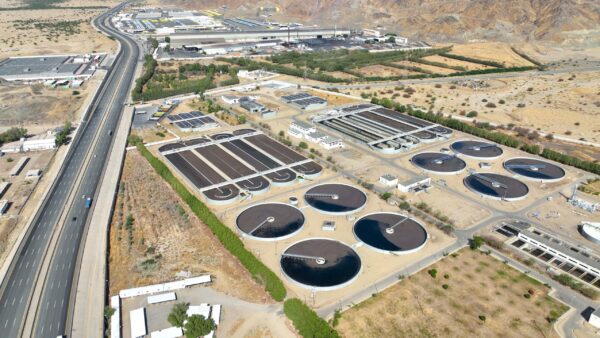

Hill international is managing or consulting on several airport projects throughout the world, ranging in size and scope from small to massive. According to Hill executives, the spate of new projects is a welcome harbinger of things to come. Over the next decade, new airports will be built in the Middle East, Africa and Asia, and existing airports will continue expanding and improving to meet an ever-growing demand. With offices and staff in nearly every corner of the globe and its reputation for success on past and current airport projects, Hill is uniquely positioned to help manage this new work, said Raouf Ghali, Hill President and Chief Operating Officer.
“This is an auspicious time in the airports market, as new airport projects at both the international and regional service levels connect even greater numbers of people to air travel,” Ghali said. “These planned projects, when coupled with our substantial existing work, make the airports market a very successful one for Hill.”
Hill’s existing contracts include a wide range of facilities and services:
Los Angeles World Airports
Hill, in joint venture with Irvine, California-based APSI Construction Management, has received a new contract from Los Angeles World Airports (LAWA) to continue providing project controls support services. The five-year contract extension has an estimated value to the joint venture of approximately $42.5 million.
Los Angeles World Airports, a department of the City of Los Angeles, is currently in the midst of a multi-billion-dollar capital improvement program at Los Angeles International Airport (LAX). The centerpiece of the program is the new Tom Bradley International Terminal project, which includes new gate and concourse areas and a Great Hall for luxury dining and retail. Additionally, there are several major airfield and facility projects underway that are part of the development program, including a new central utility plant, new taxiways and taxi lanes and renovations to other terminals.
The project will help the world’s fifth busiest airport—and the second busiest in the U.S. —meet growing passenger demand. In 2015, LAX had its busiest year ever—serving 74.9 million passengers—up 6 percent from 2014. By 2036, as many as 95 million passengers will use LAX annually. In addition, the airport needs to be ready to handle a potential spike in passenger traffic in 2024, if Los Angeles is chosen to host the 2024 Summer Olympics. (Los Angeles, Paris and Budapest are competing to host the immense event; the International Olympic Committee will make and announce its decision next September.)
Hill’s contract extension for the Tom Bradley International Terminal project is part of a comprehensive capital program involving improvements to just about every part of the airport, from runways to terminals, to people movers and roadways. The improvements will allow for more and safer air traffic, an easier commute to and within the airport, and an improved customer experience.
“This new contract is a direct result of the hard work and dedication of our project team members on our existing contract,” said Michael B. Smith, Senior Vice President and Western Regional Manager for Hill’s Project Management Group.
Similar improvements are underway at other large U.S. airports. Many international airports in U.S. cities are seeing historic levels of passenger and air traffic, but are simultaneously grappling with aging infrastructure inside and out, poor traffic flow, a lack of parking and access to public transit, and terminals that are cramped and out-of-date.
Philadelphia International Airport
For the past 26 years, Hill International has been providing Program Management Services that include a cache of highly customized services to the City of Philadelphia as its international airport—the nation’s 15th busiest—grows and evolves.
“What we do at PHL is very unique,” said Michael V. Griffin, P.E., Hill Senior Vice President and Mid-Atlantic Regional Manager. Since 1989, Hill International has helped manage the Philadelphia International Airport’s multi-billion-dollar capital program to improve facilities and increase capacity. “Our services do not fall under ‘traditional’ project management or construction management. We don’t manage the specific projects; we assist in managing the entire process,” Griffin added. “Hill’s role has evolved as the airport’s needs have evolved.”
Hill Vice President and Program Manager James P. Donnelly is part of a team that has been working alongside the airport’s Department of Engineering for several years. “We answer to the airport’s Finance Department, act as a bridge between the two departments, and oversee all of the funding sources for the capital program,” Donnelly said. “We’re another set of eyes.”
Hill’s team helps to ensure that precious funding is prudently spent, both Griffin and Donnelly explained.
An improving U.S. economy, an uptick in air travel, and increased public funding for transportation projects have placed capital projects back on the drawing boards at many international and regional airports. “Every major airport is undertaking billion-dollar plans to upgrade and keep up with both the size of the larger aircraft and the [increasing] number of smaller aircraft. Regional airports also are seeing a need to expand to meet passenger demand,” Griffin said. “It’s a constantly changing industry, and a lot of airports have terminals that are in need of upgrading or replacement.”
“PHL’s priorities right now are improving its aging infrastructure and improving the overall customer experience,” Donnelly added. “This includes everything from restrooms to roofing, mechanical and electrical systems upgrades, Information Technology upgrades, terminal expansions and aesthetic improvements.”
While U.S. airports may have long lists of capital improvements they’d like to make, their budgets are tighter than ever, Donnelly said. “That’s where we come in. We understand the process, and we can provide guidance and ideas that help the airport manage both its funding and its operations, as well as manage the planning, design, and construction of facilities, so that even the most complicated capital projects are completed efficiently, expediently and within budget to keep up with current demand.”
Newark Liberty International Airport
Hill recently received a five-year contract from the Port Authority of New York and New Jersey to provide expert professional program and project delivery and advisory services on a call-in basis in connection with the Newark Liberty International Airport Redevelopment Program in Newark, New Jersey.
Newark Liberty International Airport (EWR) is undergoing a $2.3 billion capital improvement program to redevelop aging elements at the airport. EWR’s existing Terminal A does not meet the standards of a modern airport and is at the end of its useful life. Hill will be supporting the construction of Terminal A redevelopment, which will include a new terminal building, a new parking garage complex, landside elements that encompass roadway, utility and bridge work, and airside elements that include site clearance, utility work and airside paving. The program is scheduled for completion by the end of 2022.
“EWR’s Redevelopment Program will reshape the airport and positively impact the entire region,” said John Milano, P.E., Senior Vice President and Northeast Regional Manager for Hill’s Project Management Group. “We are extremely honored to be included in such an important program.”
Phoenix Sky Harbor International Airport
In Phoenix, Arizona, the City is on the tail end of a multi-year, $1.5 billion program to upgrade and expand its airports—Phoenix Sky Harbor International Airport, Phoenix Deer Valley Airport and Phoenix Goodyear Airport—to meet historic demand and growth there.
Hill is part of a joint venture that augments the City’s staff and provides program management staff support services for various projects there.
“Our services help ensure that projects are successfully executed within schedule and budget while meeting high quality and safety standards,” said Hill Vice President Robert R. Valerio. “Hill/ASL’s support functions include project planning assistance, project management and administration, technical assistance, cost estimating and project coordination. In addition, Hill/ASL supports the planning, environmental and capital management division.”
Projects underway under the comprehensive program include the complete redevelopment and enlargement of Terminal 3 at Shy Harbor International, construction of a “Sky Train” people mover, and ancillary projects that support the expansion.
“The Hill/ASL cost control team reviews change orders, estimates, proposals and other cost-related documents for projects ranging those that will take several years to complete to those that can be completed in a day or two, and everything in between,” Valerio said. Projects involve both the international and regional airports, he added.
Phoenix’s efforts to simultaneously improve both its international and regional airports reflect another growing industry trend. Like international airports, smaller regional airports are experiencing unprecedented levels of traffic and are expanding and improving to meet both passengers’ growing needs and the use of larger aircraft.
“Capacity is the trigger for all of these projects, regardless of the size of the airport,” Valerio said. Airports of every size are seeing increases in traffic and need to increase their capacity.”
Salt Lake City International Airport
Salt Lake City International Airport serves more than 22 million passengers per year. It was built more than 50 years ago to handle half that many travelers, its website states. “Salt Lake City International as we know it today has served us well for 50 years, but it is not efficient for use as a modern hub airport,” the airport websites states. “Facilities are too small to accommodate passenger needs, and they’re not built to today’s earthquake standards.”
Since 2013, Hill has been helping the Salt Lake City Department of Airports manage the reconstruction of the airport under the new terminal redevelopment program (TRP). Expected to be completed in 2024, the multi-billion-dollar TRP includes construction of a new dual-level access terminal, replacement of an existing terminal, and construction of new parking, central utility plant, roadways and infrastructure. The new facilities, totaling 65,000-square-feet, will not only provide more space; they also will be more efficient and sustainable, and be easier for passengers to navigate.
“The new terminal redevelopment program (TRP), is now taking shape southwest of the existing terminal, being constructed all while airport operations continue, 24 hours a day”, said Max M. Shoura, a Hill Vice President who served as TRP Deputy Program Director on the Salt Lake City Airport project. “It is a very complex project, both in terms of construction and in management, for the airport to maintain continuity of service,” Shoura said. “You’re taking down multiple concourses while activating a large one, and they’re both still, simultaneously in place, in addition to new facilities the airport will construct. That is challenging.”
Hill is currently working in a blended Program Management Team (PMT) leading this effort under the direction of the Department of Airports to complete the TRP. Shoura was part of this PMT that focuses was on management of contractual matters and changes orders, helping to ensure that the Department gets what it’s paying for.
The stakes have never been higher for airports like Salt Lake City International. Airports across North America and the world, built in the 1950s and 1960s when air travel became more accessible and commonplace among everyday travelers, have been experiencing upticks in travelers, but not necessarily profits.
A worldwide economic slowdown, coupled with skyrocketing operating costs, has left many airports scrambling to fund capital projects. More and more airports are seeking government funds to help pay for needed improvements.
“Sky Harbor and Salt Lake City are unique in that they’re both using ‘banked’ funds,” Valerio explained. “But, given the current construction industry conditions and other factors, and the fact that airports’ cash flow is not going to be able to match what’s going out, more and more airports are going to be seeking federal funding.”
Regardless of the source of the funding, cost management is imperative, and will continue to be so, Shoura added. “It’s going to be increasingly important to keep construction costs contained, which is a large part of what we do,” he said.
“In the past ten years, because the economy was going into recession mode, a lot of airports delayed their construction programs because of either a lack of money or a lack of commitment to launch their programs, although the need was there. So, they held back on their programs,” Valerio added. “Construction is one of those things where you can’t snap your fingers and get something built in two or three years. It requires planning and coordination between the airports and the airlines, and the city, state and other regulatory and funding agencies.”
“So, now they want to put their programs together and are competing with each other for consultants and contractors,” Valerio continued. “Already we’re seeing costs and bids coming in a little higher now than they were a couple of years ago.”
Airlines, meanwhile, are experiencing record profits. According to the U.S. Federal Aviation Administration, “demand for air travel in 2015 grew at the fastest pace since 2007.” In addition, thanks in part to lower gas prices, an improving U.S. economy and changes in business practices, the airline industry posted profits for the sixth year in a row—the longest period of profit since the industry was deregulated in 1978.
“Stable demand, falling yields, and falling costs added up to a year of record profits for the U.S. airline industry,” the FAA states in a 2015 year-end report. “The shift in focus from market share to boosting returns on invested capital has resulted in something the industry has rarely seen—sustained profitability.”
While lackluster growth in Europe and some emerging markets has slowed or stalled planned airports projects there, air travel is nonetheless expected to increase worldwide.
In the Middle East, in particular, new airport project can’t be built fast enough, said Adel Merhi, Hill’s Oman Country Manager.
Muscat and Salalah International Airports
The growing Sultanate of Oman is dramatically expanding two of its airports to handle equally dramatic spikes in air passengers.
The Salalah International Airport is located in Salalah, the capital of the sultanate’s Dhofar governate in southeastern Oman, and functions as a secondary airport to the larger Muscat International Airport. Originally constructed in 1977, the Salalah Airport achieved international status in 2003. Since then, it has become increasingly busy, as the region has grown in popularity as both a business destination and tourist hub for passengers from both inside and outside the sultanate.
Hill was hired to help manage and expedite the expansion of Salalah International in 2013. Upgrades include the construction of a new, 65,638-square-meter passenger terminal building with 24 check-in counters, 8 passenger boarding bridges and 8 aircraft remote stands. The project also includes the construction or upgrade of 27 other airport buildings, a 57-meter-high Air Traffic Control tower, a 4,000-meter runway long enough to handle the A380 Airbus (the world’s largest aircraft), crash-fire-rescue facilities, a parking garage with a capacity for 2,200 vehicles, and centralized utilities networks. The first phase, which recently opened, will allow Salalah to handle more than one million passengers per year. Ultimately, the three-phase expansion program will allow Salalah to accommodate up to six million passengers annually.
“When Hill began work on the Salalah Airport, actual project progress was lagging behind planned progress by more than 40 percent. Our project team and the Client team succeeded in decreasing this project variance to 18 percent over the life of the project by developing and tailoring a project work plan for each package,” Merhi said. “Each project work plan, in turn, comprised a control plan for the project timelines in accordance with the contract, addressing time for completion, extension of time and rate of progress.”
Hill worked with each member of the project team to resolve challenges, build a sense of teamwork and get the project moving. Collaboration among the project team was integral to getting the project back on track, Merhi added. “We combined close monitoring with the willingness to work with every member of the team, from the contractor to the project manager, the suppliers and the Client,” he said.
In northeastern Oman, work is underway on an expansive new Muscat International Airport. Passenger traffic at Muscat International has more than doubled in the last decade, and even more traffic is expected over the next two decades.
The new airport is being constructed on a land area that totals 21 square kilometers and includes a 335,000-square-meter terminal with 116 check-in counters, 29 passenger boarding bridges, 30 aircraft remote stands, and a baggage handling system that can process 4,800 bags per hour. The Muscat project also includes ancillary buildings totaling 85,000 square meters, a 104MSL-meter-high ATC tower, and two parallel runways long enough to handle the A380 Airbus, and a hotel. Work is progressing in phases, the first of which is expected to be completed in mid- to late-2017. The sultanate hopes that Muscat will be among the world’s top 20 airports by 2020 and that it eventually will be able to accommodate 48 million passengers a year.
Merhi said that getting there requires effective management, collaborative decision-making and sharp attention to detail each and every day. “Using our in-depth experience with fast-tracked, complex projects, we have prepared and customized project work plans that combined multiple supervision, time, cost and quality management tools; developed an Information Technology system that allows us to stay on top of the schedule and any variances, and have mobilized a large project team that peaked at 403 members to get the work off the ground,” Merhi explained. “As Hill progresses with the development of the Muscat International Airport, we continue to engage with and facilitate the interface with the myriad Contractors, the Client and other Stakeholders to keep the program on track.”
“With the support of the Client team, Hill managed to deliver in record time several major facilities that are now operational, including a new runway and associated runways, the Control Tower, the PACA Headquarters and various support facilities at Muscat,” Merhi added. “The support of the Client was instrumental in helping us achieve our goals.”
Abu Dhabi International Airport
Like its counterparts in Muscat and Salalah in Oman, the Abu Dhabi International Airport is expanding to meet unprecedented demand. Hill, in joint venture with AECOM, is providing construction management and supervision services to the Abu Dhabi Airports Company during construction of its new Midfield Terminal Complex.
Abu Dhabi International Airport is the primary gateway to the Emirate of Abu Dhabi. As Abu Dhabi evolves into a global city where increasing numbers of people choose to live and to visit, the passenger traffic at Abu Dhabi International Airport has also been growing in tandem.
The centerpiece of the capital program is the Midfield Terminal Complex, which includes a state-of-the-art terminal capable of handling up to 40 million passengers per year. The development program will also include airside and landside infrastructure, a multi-story car park, cargo building, catering building, maintenance complex and other support facilities.
The Midfield Terminal Building will be the largest in Abu Dhabi, and one of the region’s most architecturally impressive structures. The Terminal will be 700,000 square meters in area. The central space of the building could hold three full-sized football fields and features a ceiling 52 meters (171 feet) tall at its highest point.
Bahrain International Airport
In Bahrain, Hill is providing project management consultancy services to the Bahrain Airport Company S.P.C. for a major expansion at its international airport in Manama, the kingdom’s bustling capital. Like others in the region, Bahrain International Airport is experiencing unprecedented growth, and is attracting more international airlines to use the airport as a regional transfer and aviation services hub.
The expansion program at BIA includes a new passenger terminals, aprons, ancillary buildings and associated facilities such as Central Utility Complex, Fire station, security gate, multistory car parking in addition to necessary road utilities and infrastructure upgrades. The program also includes the development of a master plan for an adjacent Airport Landside Development with state-of-the-art facilities and infrastructure, including hotels, conference centers, retail, and recreational facilities.
When completed in 2020, the terminal will allow BIA to accommodate up to 13.5 million passengers per year.
Hill’s responsibilities include planning, time control, time management, preparing and evaluating contractual documents, design overview, value engineering, technical, legal and financial support services, staff augmentation and project administration and coordination in order to achieve an efficient performance of the design and construction of the project.
International airports aren’t the only ones planning to expand.
“The region does not now have sufficient number of airports. Smaller airports also need to expanded,” Merhi said. Also, fuel companies in the Middle East will need to expand and upgrade their airports.
In addition, when conflicts in places like Yemen, Syria, Libya and Iraq are resolved, those countries will need to rebuild, with airports at the top of their lists. Merhi and his team are ready.
“We have a strong team of professionals with much experience in airports, from terminals to Information Technology, to navigation systems and runways,” he said. “We also have built a solid reputation in the region for successfully managing even the most complex projects. I’m confident that, when these countries begin to re-build, we will be ready to help.”
by Tricia M. McCunney
Share

June 23, 2025 | Articles
Jeffrey Hurley Joins Hill’s Northern California Rail Practice

June 23, 2025 | Articles
Ready, Set, Grow: First VP Chad Koelling Takes Charge of Hill’s Mountain West Region

June 8, 2025 | Articles
PMO in Saudi Arabia: The Holistic Approach to Realizing a National Mega-Portfolio

June 1, 2025 | Articles

May 26, 2025 | Articles

May 12, 2025 | Articles
Keeping Your Water/Wastewater Programs Flowing with Public Relations

April 27, 2025 | Articles
Oiling the Machine: Steps to Successful Permitting on Infrastructure Megaprojects

April 20, 2025 | Articles
Sustainable Scaling: Solutions for Managing Risk on Europe’s Data Center Projects